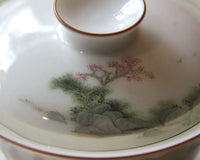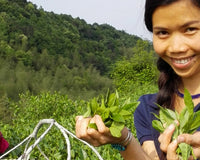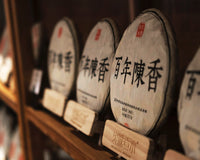Both Sheng and Shu (aka Raw and Ripe) Puerh tea are made from the same finished leaf known as Mao Cha (毛茶). In this article we focus on how the Sheng Puerh Mao Cha is produced.
The bulk Mao Cha is processed using tea leaf plucked from 'big leaf varietal' tea bushes and tea trees. The process involves the following stages of production:
Dehydration (Withering) 晒青
After plucking, tea leaves are carried back in linen satchels or bamboo baskets for processing. In dry weather conditions, the picked tea leaves are scattered on bamboo mats on open-air balconies and exposed to the air and light.
This natural dehydration, or sun-drying, of the leaves is the first phase of 'Raw' Puerh production. As the leaves dehydrate, water evaporates into the atmosphere, stimulating a chemical transformation inside the leaf.
On a practical level, the loss of water during this stage helps to soften the leaves, increasing the suppleness of the leaf in preparation for the 'Kill Green' stage.

Stir-Fry (Kill Green) 杀青
Once the leaves have achieved the requisite level of softening, they are gathered into small batches and transferred to a deep, concave metal pan, or wok, for stir-frying. The wok is fixed onto a concrete mound and heated from below. The partially-dehydrated leaves are then tossed against the scolding sides of the wok to dry-fry them.
This stage appears easy, but it is a complex stage which requires a highly-developed understanding of the leaf condition. Higher quality Puerh depends on the ability of the tea maker to expose leaves to an even degree of heat.
The application of heat during this Kill Green stage immobilises the enzymic activity inside the leaf and excess water is further evaporated. Simultaneously, stir-frying also dispels the natural 'green' gases that can impair a tea's aroma. The action of stir-frying further softens the leaf in preparation for manual shaping and twisting.

Shaping
The freshly 'fried' leaves are then twisted and shaped by hand. This third stage of Raw Puerh production requires strength combined with careful manipulation; the leaves are twisted and rolled softly at first, then with increasing force.
The continuous pressing, turning, and kneading of the tea leaf helps to further break down the internal structure, facilitating a reshaping of their external appearance. After some reshaping, the leaves also begin to lose their vibrant green lustre and appear slightly duller.
Sun-drying
Now that the leaves have passed through the stages of dehydration, Kill Green and shaping, they are left to recover from this exhaustive process and placed onto bamboo mats for a period of sun-drying. The last stage in the production of 'Raw' Puerh allows for another final, natural dehydration of the Puerh leaf.
Sorting
Once dried the Mao Cha is then sorted to remove undesired leaf and twigs from large, circular bamboo trays. These leaves are now ready to be enjoyed as loose Puerh or will be compressed into cakes.
Compression
The loose Mao Cha is weighed and placed into buckets perforated at the base, which are then placed over a steamer along with the Nei Zhang 内张, a small piece of paper with the brand's logo. The steam passes through the perforations and disperses through the compacted leaves. This short period of steaming helps soften the leaf and increase its malleability.
Final Dehydration
At this point the cakes still retain a certain amount of moisture, so they are removed from their linen wrap and placed into a dehydration room to allow natural evaporation. It is vital that the Puerh cakes are fully dehydrated before being packaged, otherwise any moisture concealed or trapped inside the packaging will adversely affect the quality of the Puerh tea cake.
Packaging
Once the cake is fully dry, the tea can then be packed.
If the tea is being sold as tea cakes, each cake is wrapped in a paper. Depending on the quality of the tea, the paper may be hand-made (this is said to improve the breathability).
Traditional packaging methods then require seven individual cakes, called 'Seven Sons' (Qi Zi Bing 七子饼), to be wrapped in a leaf and bound into what is known as a 'Tong' 桶.
Further reading
The other main styles of Puerh is called Shu (or Ripe) Puerh. Why not read our article about Shu Puerh Production to understand the processes involved?











